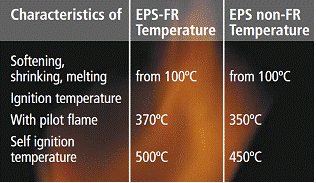
- About
- Products
- Solutions
- Partners
- Resources
- Projects
- Installation
- News
- Contact Us
 info@b-panel.com | +62-22 686 7077
info@b-panel.com | +62-22 686 7077
Abstract
Fire is a disaster for the experience. In this article the role of insulation material on the fire safety of buildings will be discussed, focusing on Expanded Polystyrene (EPS). This article aims to measure clearly the performance of fire from the EPS. The aspects of fire performance in terms of EPS are the result of heat release, smoke, and toxic.
EPS is obtained primarily from styrene monomer and developed to form a cellular structure from the closed cell. When considering fire behavior of any building material, it is important to recognize that the assessment must be based on its performance on the final conditions of use. This performance depends not only on the chemicals that make up the material, but for a wider range of physical conditions. Thus, the important factors that must be considered to determine the potential fire hazard of EPS are:
Almost all organic building materials such as polystyrene foam are highly flammable. However, in practice the behavior of fire depends on the conditions in which the EPS is used and other materials attached to the EPS. This will differ depending whether the cellular material is made of EPS with or without flame retardant additives. Other materials which bind to the EPS will also affect the behavior of the fire. So, it is recommended that EPS should be protected by a coating material or fully encapsulated, such as the b-panel® product. When burning, EPS will produce carbon monoxide and styrene. During the combustion process, styrene will break down into carbon dioxide, water, and some soot.(Source: European Manufacturers of EPS).
There are two types of EPS, which are the standard type and Fire-Retardant/FR. The FR type is more difficult to burn and significantly reduce the rate of spread of flame. If EPS is exposed to temperatures above 100oC, EPS will soften, shrink, and eventually melt. At higher temperatures, flammable gases are formed from molten EPS which is decomposed. Whether these gases can be burned depends on the temperature, the heat exposure period, and air flow. EPS that melts will not burn just by welding sparks or cigarette flame. However, a small flame readily burn EPS, except if the EPS contains fire retardant additive material (as in the case of EPS-FR type). Here are the characteristics of two types of EPS.
Table 1 – T the characteristics of two types of EPS

Heat release. One of the most important factor is rate of heat release/RHR. For high heat flux (above 20 kW/m2), overall RHR and peak RHR are lower for EPS-FR compared to standard EPS. The calorific volume per volume of EPS between 540 MJ/m3 to 1250 MJ/m3 lower than other insulations (cellulose, fiber, and timber) which are between 7150 MJ/m3 to 10400 MJ/m3 (ISO 5660). The table below shows some differences in the contribution of fire load from a variety of insulation materials when compared to the proportional insulation value where it can be seen that the EPS has the lowest fire load compared to the XPS (Extruded Polystyrene) and MW (Mineral Wool). (F. H. Prager, Celluler Polymer nr.20-3/2001 “Research in the causes of fire”).
Tabel 2 – Fire load of selected materials
Catatan: EPS (Expanded Polystyrene), XPS (Extruded Polystyrene), dan MW (Mineral Wool)
Toxicity. Poison is one of the effects of smoke. Although burning EPS causes black smoke, toxic generated from smoke is much smaller than from other frequently-used materials. Below is a table of results of research conducted on a small scale by the TNO Centre for Fire Safety in 1980.
Table 3 – Number of Toxins In The Smoke Generated from Some Material

From the table above can be seen that the performance of EPS is very good because the EPS has a low density and light-weight (98% consist of air).
In addition, there are no negative effects of fire retardant additives in the EPS-FR. Pentane gas (a pure hydrocarbon) which is used as a blowing agent to expand polystyrene into EPS does not have an important role when there is a fire because pentane gas is unstable and decomposed in the atmosphere into carbon monoxide and water in few hours.
As mentioned previously, EPS should be protected when used in buildings that have a risk of fire. When EPS as insulation has been applied correctly, it will only start burning if the materials around EPS have been burned out or destroyed.
EPS performance is very good in the event of fire, because its heat release, smoke, and toxins rates are low compared with other insulation materials. However, this is relevant if the EPS as an insulation material is exposed (unprotected). When EPS is protected by other materials, or encapsulated in concrete, as in the case of b-panel®, the concern of heat release, smoke, and toxins is truly minimized.
Source: b-panel® Engineering Team